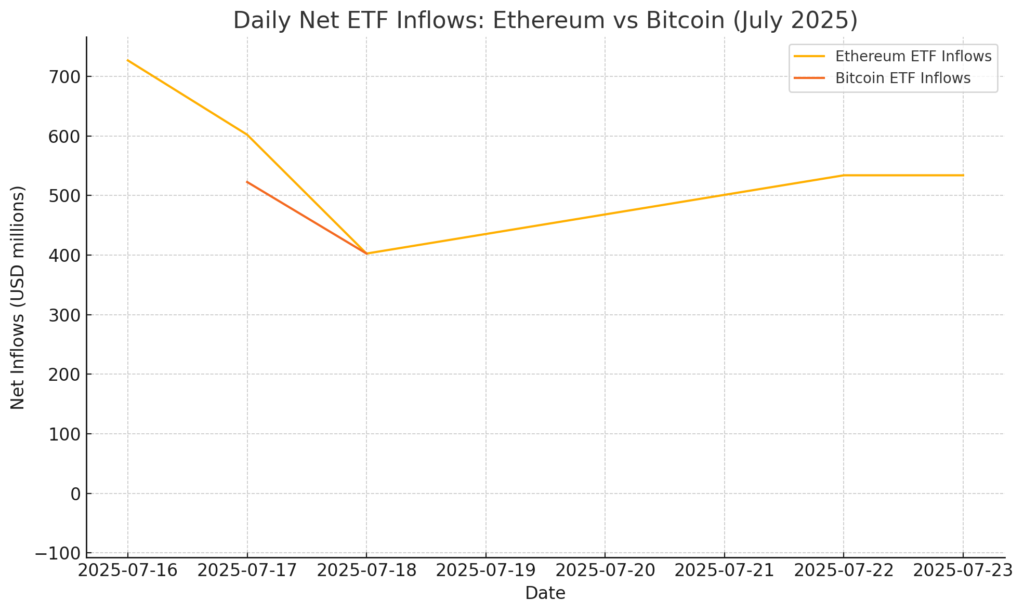
Main Points:
- Record-breaking inflows: Ethereum ETFs attracted over $4 billion in net inflows over a recent two-week span, surpassing Bitcoin ETF inflows for the first time.
- Shifting institutional priorities: Daily net inflows into Ethereum ETFs hit peaks of $726.7 million (July 16), $602 million (July 17), and maintained a 13‑day consecutive streak, signaling conviction beyond speculative trading.
- Regulatory catalysts: Potential passage of the GENIUS Act and CLARITY Act, along with anticipated SEC approval of staking features by year-end, enhances Ethereum’s attractiveness.
- Diverse use cases: Ethereum’s role as a programmable platform for DeFi, NFTs, and emerging tokenized securities underpins its institutional demand.
- Portfolio diversification lesson: Japanese investors should consider balancing Bitcoin “digital gold” with Ethereum’s “programmable money” to mitigate market-specific risks.
1. Record-breaking Inflows Signal a New Era in Crypto ETFs
In mid-July 2025, spot Ethereum ETFs witnessed a historic momentum, drawing a staggering $4 billion in net inflows over a two-week stretch ending July 23. On July 16 alone, daily inflows hit $726.74 million, followed by $602 million on July 17, and a further $533.87 million on July 23, marking a 13‑trading-day inflow streak. In contrast, Bitcoin ETFs saw net outflows of $85.96 million on July 23, and a 12‑day positive inflow streak ended with $131.4 million in outflows on July 21. This divergence highlights a strategic rotation of institutional capital toward Ethereum, rather than a blanket sell-off in crypto assets.
While Bitcoin ETFs led with $4.2 billion in inflows since July 4, Ethereum’s cumulative two-week inflow of $8.32 billion at its pace represents an inflection point where institutional priorities increasingly favor programmable blockchain platforms over “digital gold”. This shift is not merely a short-lived phenomenon but suggests growing conviction in Ethereum’s long‑term utility.
2. Regulatory Catalysts: GENIUS Act, CLARITY Act, and Staking Approval
A supportive regulatory backdrop has bolstered Ethereum’s ETF appeal. Under the Trump administration, proposed legislation like the GENIUS Act and CLARITY Act promises clearer definitions for token classifications and stablecoin frameworks, reducing uncertainty for institutional investors. Furthermore, the U.S. Securities and Exchange Commission is anticipated to greenlight staking within spot Ethereum ETFs by year‑end 2025, unlocking yield‑bearing opportunities analogous to bond coupons. This mechanism could attract yield‑seeking capital at a time when traditional fixed-income markets remain volatile.
3. Ethereum’s Diverse Use Cases Drive Institutional Confidence
Unlike Bitcoin—primarily viewed as a store of value—Ethereum functions as the backbone of decentralized finance (DeFi), non‑fungible tokens (NFTs), and emerging applications like tokenized government securities. The explosion of DeFi protocols and token standards (ERC‑20, ERC‑721) on Ethereum has created a robust ecosystem that institutional allocators view as a growth engine. On July 18, Ethereum’s price surged to a six‑month high of $3,675.81 before settling at $3,601.40, driven by ecosystem activity and ETF inflows.
Major corporates have also bolstered demand. BitMine Immersion Technologies announced a treasury accumulation of over 300,000 ETH (~$1.08 billion at $3,600/ETH), while Circle’s IPO success and stablecoin issuance on Ethereum further validate the network’s enterprise appeal. 図表1の挿入位置
上記「Record-breaking Inflows Signal…」セクションと以下「Regulatory Catalysts…」セクションの間に図表1を配置。
4. Implications for Japanese Investors: Embrace Portfolio Diversification
Japanese investors have entered a phase where they should reevaluate their cryptocurrency portfolios. While Bitcoin ETFs are easily influenced by macro factors as “digital gold,” Ethereum ETFs tend to be linked to fundamentals such as the growth of DeFi, NFT trading volume, and staking rewards. Combining the two makes it possible to hedge against different market cycles.
In addition, the spread of Ethereum ETFs will lower the technical and regulatory hurdles that have been barriers to entry into the cryptocurrency market, promoting the entry of traditional investors. This is an opportunity for Japanese institutional investors and family offices for wealthy individuals to consider Ethereum as a formal alternative asset class.
5. Conclusion
Ethereum ETFs overtaking Bitcoin in net inflows marks a watershed moment for the cryptocurrency market. Driven by record-breaking capital allocation, supportive regulatory shifts, and Ethereum’s multifaceted ecosystem, institutional investors are reshaping their digital asset strategies. For Japanese investors, the lesson is clear: diversify beyond “digital gold”—embrace the “programmable money” of Ethereum to navigate the evolving landscape and capture emerging opportunities.Main Points:
- Record-breaking inflows: Ethereum ETFs attracted over $4 billion in net inflows over a recent two-week span, surpassing Bitcoin ETF inflows for the first time.
- Shifting institutional priorities: Daily net inflows into Ethereum ETFs hit peaks of $726.7 million (July 16), $602 million (July 17), and maintained a 13‑day consecutive streak, signaling conviction beyond speculative trading.
- Regulatory catalysts: Potential passage of the GENIUS Act and CLARITY Act, along with anticipated SEC approval of staking features by year-end, enhances Ethereum’s attractiveness.
- Diverse use cases: Ethereum’s role as a programmable platform for DeFi, NFTs, and emerging tokenized securities underpins its institutional demand.
- Portfolio diversification lesson: Japanese investors should consider balancing Bitcoin “digital gold” with Ethereum’s “programmable money” to mitigate market-specific risks.
1. Record-breaking Inflows Signal a New Era in Crypto ETFs
In mid-July 2025, spot Ethereum ETFs witnessed a historic momentum, drawing a staggering $4 billion in net inflows over a two-week stretch ending July 23. On July 16 alone, daily inflows hit $726.74 million, followed by $602 million on July 17, and a further $533.87 million on July 23, marking a 13‑trading-day inflow streak. In contrast, Bitcoin ETFs saw net outflows of $85.96 million on July 23, and a 12‑day positive inflow streak ended with $131.4 million in outflows on July 21. This divergence highlights a strategic rotation of institutional capital toward Ethereum, rather than a blanket sell-off in crypto assets.
While Bitcoin ETFs led with $4.2 billion in inflows since July 4, Ethereum’s cumulative two-week inflow of $8.32 billion at its pace represents an inflection point where institutional priorities increasingly favor programmable blockchain platforms over “digital gold”. This shift is not merely a short-lived phenomenon but suggests growing conviction in Ethereum’s long‑term utility.
2. Regulatory Catalysts: GENIUS Act, CLARITY Act, and Staking Approval
A supportive regulatory backdrop has bolstered Ethereum’s ETF appeal. Under the Trump administration, proposed legislation like the GENIUS Act and CLARITY Act promises clearer definitions for token classifications and stablecoin frameworks, reducing uncertainty for institutional investors. Furthermore, the U.S. Securities and Exchange Commission is anticipated to greenlight staking within spot Ethereum ETFs by year‑end 2025, unlocking yield‑bearing opportunities analogous to bond coupons. This mechanism could attract yield‑seeking capital at a time when traditional fixed-income markets remain volatile.
3. Ethereum’s Diverse Use Cases Drive Institutional Confidence
Unlike Bitcoin—primarily viewed as a store of value—Ethereum functions as the backbone of decentralized finance (DeFi), non‑fungible tokens (NFTs), and emerging applications like tokenized government securities. The explosion of DeFi protocols and token standards (ERC‑20, ERC‑721) on Ethereum has created a robust ecosystem that institutional allocators view as a growth engine. On July 18, Ethereum’s price surged to a six‑month high of $3,675.81 before settling at $3,601.40, driven by ecosystem activity and ETF inflows.
Major corporates have also bolstered demand. BitMine Immersion Technologies announced a treasury accumulation of over 300,000 ETH (~$1.08 billion at $3,600/ETH), while Circle’s IPO success and stablecoin issuance on Ethereum further validate the network’s enterprise appeal.

4. Implications for Japanese Investors: Embrace Portfolio Diversification
Japanese investors have entered a phase where they should reevaluate their cryptocurrency portfolios. While Bitcoin ETFs are easily influenced by macro factors as “digital gold,” Ethereum ETFs tend to be linked to fundamentals such as the growth of DeFi, NFT trading volume, and staking rewards. Combining the two makes it possible to hedge against different market cycles.
In addition, the spread of Ethereum ETFs will lower the technical and regulatory hurdles that have been barriers to entry into the cryptocurrency market, promoting the entry of traditional investors. This is an opportunity for Japanese institutional investors and family offices for wealthy individuals to consider Ethereum as a formal alternative asset class.
5. Conclusion
Ethereum ETFs overtaking Bitcoin in net inflows marks a watershed moment for the cryptocurrency market. Driven by record-breaking capital allocation, supportive regulatory shifts, and Ethereum’s multifaceted ecosystem, institutional investors are reshaping their digital asset strategies. For Japanese investors, the lesson is clear: diversify beyond “digital gold”—embrace the “programmable money” of Ethereum to navigate the evolving landscape and capture emerging opportunities.

